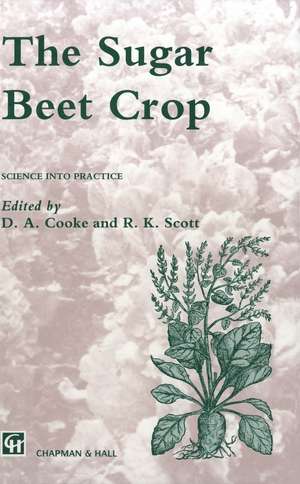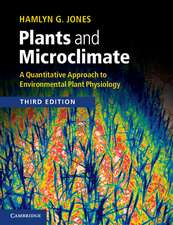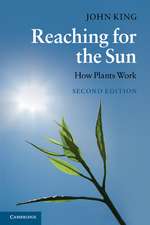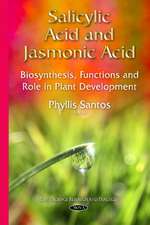The Sugar Beet Crop: World Crop Series
Autor D.A. Cooke, J.E. Scotten Limba Engleză Paperback – 28 sep 2011
Preț: 963.47 lei
Preț vechi: 1174.96 lei
-18% Nou
Puncte Express: 1445
Preț estimativ în valută:
184.42€ • 200.39$ • 155.01£
184.42€ • 200.39$ • 155.01£
Carte tipărită la comandă
Livrare economică 21 aprilie-05 mai
Preluare comenzi: 021 569.72.76
Specificații
ISBN-13: 9789401066549
ISBN-10: 940106654X
Pagini: 700
Ilustrații: 704 p.
Dimensiuni: 155 x 235 x 37 mm
Greutate: 0.96 kg
Ediția:Softcover reprint of the original 1st ed. 1993
Editura: SPRINGER NETHERLANDS
Colecția Springer
Seria World Crop Series
Locul publicării:Dordrecht, Netherlands
ISBN-10: 940106654X
Pagini: 700
Ilustrații: 704 p.
Dimensiuni: 155 x 235 x 37 mm
Greutate: 0.96 kg
Ediția:Softcover reprint of the original 1st ed. 1993
Editura: SPRINGER NETHERLANDS
Colecția Springer
Seria World Crop Series
Locul publicării:Dordrecht, Netherlands
Public țintă
ResearchCuprins
1 History of the crop.- 1.1 Origins of beet growing.- 1.2 Evolution of cultivated Beta species.- 1.3 Achard and the first beet sugar factory.- 1.4 The early history of sugar-beet breeding.- 1.5 Development of the beet sugar industry in the nineteenth century.- 1.6 Improvements in growing techniques and expansion of sugar-beet cultivation in the twentieth century.- 1.7 Sugar beet in retrospect and prospect.- 1.8 Historical time-table.- References.- 2 Biology and physiology of the sugar-beet plant.- 2.1 Introduction.- 2.2 Crop establishment and vegetative growth.- 2.3 Production and distribution of assimilates.- 2.4 Reproductive growth 60 References.- 3 Genetics and breeding.- 3.1 Introduction.- 3.2 Objectives of sugar-beet breeding.- 3.3 Characters subjected to selection.- 3.4 The inheritance of specific characters.- 3.5 Allopolyploidy in sugar-beet breeding.- 3.6 Selection methods.- 3.7 Synthetic varieties in sugar beet.- 3.8 Background to hybrid breeding in sugar beet.- 3.9 Hybrid breeding methods and development of hybrid varieties.- 3.10 Breeding for specific characters.- 3.11 Impact of new technologies on sugar-beet breeding.- References.- 4 Seed production and quality.- 4.1 Introduction.- 4.2 Seed production — indirect (steckling transplant) method.- 4.3 Seed production — direct (overwintering) method.- 4.4 Seed production — harvest.- 4.5 Seed quality.- 4.6 Seed law requirements.- References.- 5 Soil management and crop establishment.- 5.1 Obj ectives of tillage.- 5.2 Primary tillage.- 5.3 Secondary tillage, sowing and post-sowing tillage.- 5.4 Mechanical weed control.- 5.5 Soil compaction.- 5.6 Subsoil loosening.- 5.7 Protection against wind erosion.- 5.8 Reduced tillage.- References.- 6 Crop physiology and agronomy.- 6.1 Introduction.- 6.2 The physiology ofcrop growth.- 6.3 Analysing agronomy in physiological terms.- 6.4 Analysing the effects of weeds andyirus yellows in physiological terms.- 6.5 The application of physiological principles to the future development of the industry.- References.- 7 Nutrition.- 7.1 Introduction.- 7.2 Nitrogen.- 7.3 Phosphorus and sulphur.- 7.4 Potassium and sodium.- 7.5 Calcium and magnesium.- 7.6 Micronutrients.- References.- 8 Water use and irrigation.- 8.1 Introduction.- 8.2 Sugar-beet plants and water.- 8.3 Water use.- 8.4 Water use and crop growth.- 8.5 Responses to irrigation.- 8.6 Irrigation practice.- References.- 9 Rhizomania.- 9.1 Introduction.- 9.2 Symptoms and damage.- 9.3 Causal agents.- 9.4 Factors affecting disease development.- 9.5 Spread of the disease.- 9.6 Control.- 9.7 Conclusions.- References.- 10 Diseases.- 10.1 Introduction.- 10.2 Major virus diseases.- 10.3 Virus diseases of minor or unknown importance.- 10.4 Major fungal diseases.- 10.5 Minor or localised fungal diseases.- 10.6 Diseases caused by bacteria and bacteria-like organisms.- References.- 11 Pests.- 11.1 Introduction.- 11.2 Effects of pests on plant growth and crop yield.- 11.3 Distribution, biology, and pathogenicity of the major pests.- 11.4 Minimising yield losses caused by pests.- References.- 12 Weeds and weed control.- 12.1 Introduction.- 12.2 Weeds.- 12.3 Weed competition and the effect of time of removal.- 12.4 Weed control.- 12.5 Weed control outside the sugar-beet crop.- 12.6 Herbicide resistance.- 12.7 Herbicide soil residues.- 12.8 Summary and future prospects.- References.- 13 Opportunities for manipulation of growth and development.- 13.1 The rationale for growth regulation.- 13.2 Chemical regulation of growth and development.- 13.3 A molecular biological approach to regulation of growth anddevelopment.- 13.4 Conclusions.- References.- 14 Storage.- 14.1 Introduction.- 14.2 Amount of losses.- 14.3 Causes of losses.- 14.4 Reducing storage losses.- References.- 15 Root quality and processing.- 15.1 Introduction.- 15.2 Historical overview of technical quality.- 15.3 Concepts of good beet quality.- 15.4 Quality parameters.- 15.5 Factors influencing quality.- 15.6 Evolution of beet quality.- 15.7 Concluding remarks.- References.- 16 By-products.- 16.1 Introduction.- 16.2 Sugar-beet tops.- 16.3 Sugar-beet pulp.- 16.4 Sugar-beet molasses.- 16.5 Molassed sugar-beet pulp (feed).- 16.6 Beet vinasse.- 16.7 Concluding remarks.- References.
Recenzii
The book clearly presents a very comprehensive account of the crop. The book clearly provides a broad and considered outline of this major crop...it should be available widely in the libraries of colleges, universities and research institutes wherever crop science is studied - Journal of Agricultural Science



















